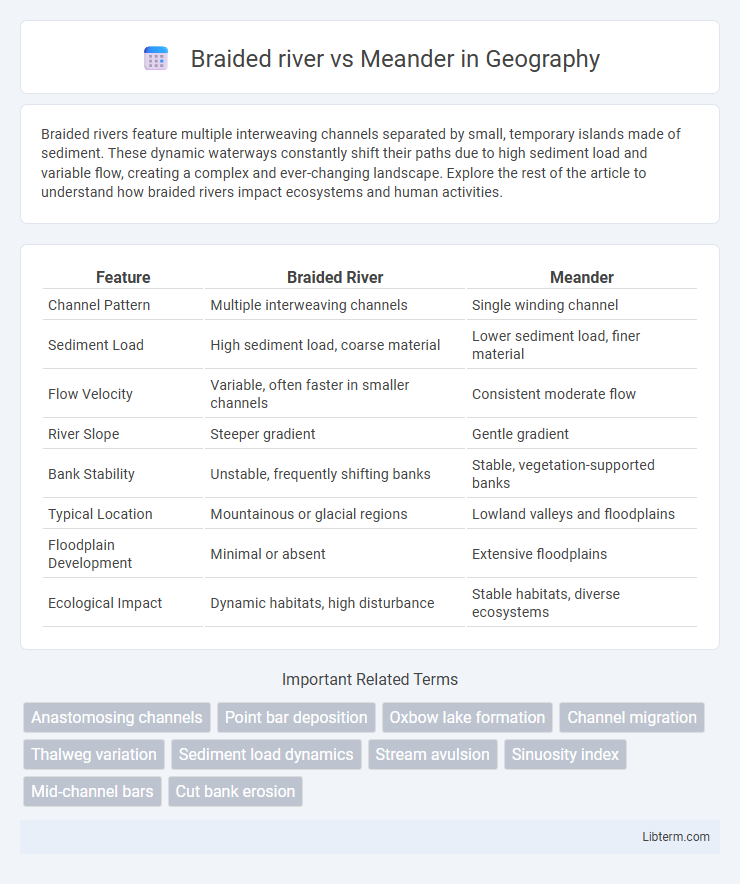Braided rivers feature multiple interweaving channels separated by small, temporary islands made of sediment. These dynamic waterways constantly shift their paths due to high sediment load and variable flow, creating a complex and ever-changing landscape. Explore the rest of the article to understand how braided rivers impact ecosystems and human activities.
Table of Comparison
| Feature | Braided River | Meander |
|---|---|---|
| Channel Pattern | Multiple interweaving channels | Single winding channel |
| Sediment Load | High sediment load, coarse material | Lower sediment load, finer material |
| Flow Velocity | Variable, often faster in smaller channels | Consistent moderate flow |
| River Slope | Steeper gradient | Gentle gradient |
| Bank Stability | Unstable, frequently shifting banks | Stable, vegetation-supported banks |
| Typical Location | Mountainous or glacial regions | Lowland valleys and floodplains |
| Floodplain Development | Minimal or absent | Extensive floodplains |
| Ecological Impact | Dynamic habitats, high disturbance | Stable habitats, diverse ecosystems |
Introduction to Braided Rivers and Meanders
Braided rivers feature multiple interwoven channels separated by small, often temporary, islands formed by sediment deposition, typically occurring in rivers with high sediment loads and variable water flow. Meanders are sinuous, curved river bends that develop in rivers with stable flow and fine sediment, characterized by erosion on the outer banks and deposition on the inner banks. Understanding the differences between braided rivers and meanders is crucial for studying sediment transport, river morphology, and ecosystem dynamics.
Defining Braided Rivers
Braided rivers are characterized by multiple intertwined channels separated by small, often temporary, islands called braid bars, formed due to high sediment load and variable discharge. These rivers typically occur in areas with steep gradients and abundant sediment supply, causing frequent channel shifts. Unlike meanders, which have single, sinuous channels, braided rivers exhibit a complex network of channels that continuously split and rejoin.
Characteristics of Meandering Rivers
Meandering rivers are characterized by their sinuous, looping bends that form as water erodes the outer banks and deposits sediment on the inner banks, creating a dynamic, winding channel pattern. These rivers typically develop in flatter landscapes with finer sediment, promoting lateral erosion and point bar formation. The flow velocity varies across the channel, with slower currents on the inside of bends encouraging sediment deposition and faster currents on the outside causing erosion and bank undercutting.
Formation Processes: Braided vs. Meandering
Braided rivers form through the deposition of coarse sediments like gravel and sand, resulting in multiple interweaving channels that develop where high sediment loads and variable water flow cause frequent channel shifts. Meandering rivers develop through lateral erosion and deposition on point bars within a single, sinuous channel, driven by steady water flow and fine to medium sediment sizes that promote bank erosion and sediment deposition along curves. The contrasting formation processes reflect differences in sediment supply, channel slope, and flow variability, influencing river morphology and dynamics.
Sediment Load and Channel Patterns
Braided rivers exhibit high sediment loads with coarse, easily erodible material, leading to multiple shallow, interweaving channels separated by transient bars. In contrast, meandering rivers transport finer sediment loads with more stable, sinuous single channels that erode laterally, creating point bars and cut banks. Sediment size and flow variability are key factors influencing channel pattern formation in both braided and meandering river systems.
Influence of Slope and Flow Velocity
Braided rivers typically form in steep slopes with high flow velocity, causing frequent sediment deposition and channel splitting. Meandering rivers develop on gentle slopes with lower flow velocity, promoting lateral erosion and smooth, sinuous river bends. The slope gradient and flow velocity directly influence sediment transport dynamics, channel stability, and river morphology evolution.
Ecological Impacts of River Types
Braided rivers create diverse habitats with high sediment transport and frequent channel changes, supporting dynamic aquatic and riparian ecosystems that favor species adapted to disturbance. Meandering rivers provide stable, nutrient-rich floodplains that promote diverse plant communities, enhance groundwater recharge, and support complex food webs. Ecological impacts differ as braided systems maintain habitat heterogeneity and connectivity, while meanders offer long-term stability crucial for wetlands and terrestrial wildlife.
Geographical Distribution and Examples
Braided rivers commonly occur in glacial and mountainous regions with abundant sediment supply, such as the Brahmaputra in India and the Platte River in the United States, characterized by multiple interwoven channels. Meandering rivers are typically found in low-gradient, flat plains like the Mississippi River in North America and the Nile River in Africa, where a single sinuous channel dominates. The geographical distribution reflects variations in sediment load, slope, and water discharge influencing river morphology.
Human Interactions and Management
Human interactions with braided rivers often involve challenges in flood control and sediment management due to their multiple shifting channels, necessitating adaptive infrastructure such as levees and sediment traps. In contrast, meandering rivers typically require management strategies focused on bank stabilization and erosion prevention to protect agricultural land and settlements along curved channels. Both river types demand tailored approaches to balance ecological integrity with human land use, emphasizing sustainable water resource management and habitat conservation.
Conclusion: Key Differences and Significance
Braided rivers consist of multiple interconnected channels separated by sandbars, forming a network of shifting pathways, while meandering rivers feature a single, sinuous channel with distinct bends. The key difference lies in their channel patterns and sediment transport dynamics; braided rivers indicate high sediment load and variable discharge, whereas meanders form in more stable flow conditions with finer sediments. Understanding these distinctions is crucial for river management, ecological conservation, and predicting flood behavior in diverse fluvial environments.
Braided river Infographic

 libterm.com
libterm.com